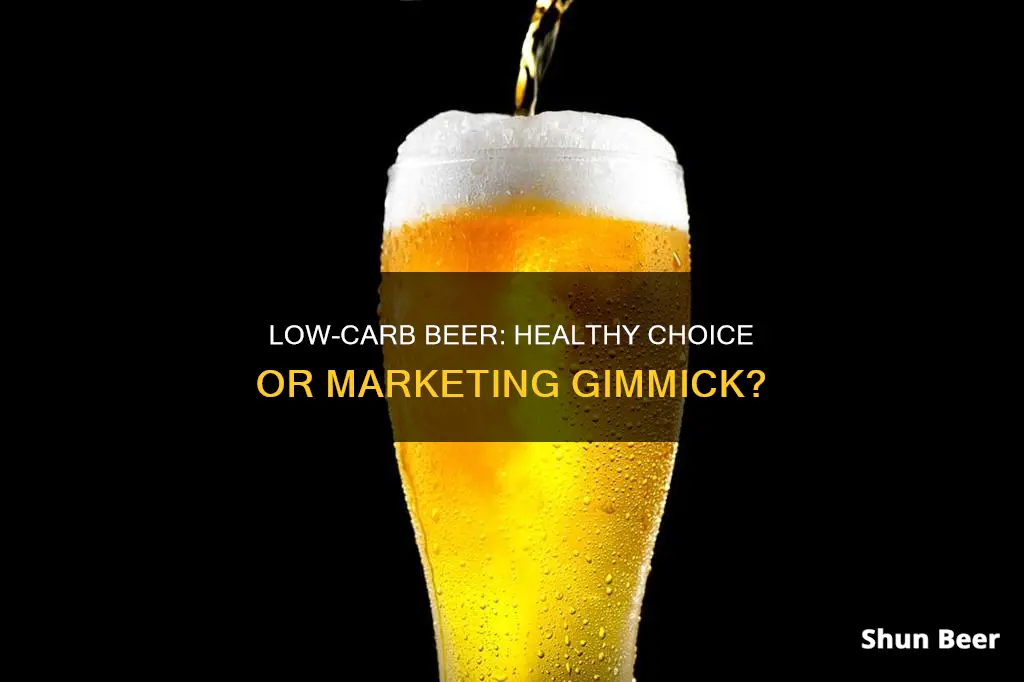
Low-carb beers are often brewed with distinct enzymes that break down the carbohydrates into alcohol instead of allowing them to remain as starch. While low-carb beers have slightly fewer kilojoules than regular beers, they are not necessarily healthier, and drinking them will not prevent weight gain. However, for those watching their carbohydrate intake, there are several low-carb beer options available, including Budweiser Select 55, Coors Light, and Corona Premier.
| Characteristics | Values |
|---|---|
| Calories | 55-180 |
| Carbohydrates | 0-14.6g |
| ABV | 2-8.3% |
What You'll Learn

Low-carb beers are not healthier than regular beers
Most beers are already relatively low in carbohydrates, with a typical lager or ale containing 1.4 grams of carbohydrates per 100ml. "Low-carb" beers, such as Pure Blonde, have just over 0.5 grams, while "lower-carb" beers like Carlton Dry have 1.9 grams. The difference is minimal and is not significant enough to make a meaningful impact on health.
The alcohol in beer is the main contributor to its high kilojoule content, with around 80% of the kilojoules in a typical beer coming from alcohol, while only about 15% come from carbohydrates and less than 1% from sugar. Therefore, it is important to choose beers with a lower alcohol content if you are concerned about weight gain and health risks.
Additionally, alcohol can impede weight loss by stimulating appetite and decreasing inhibitions, leading to increased food intake. Even if a beer is low in carbs and calories, it can still contribute to weight gain due to its alcohol content.
When it comes to weight loss and overall health, it is crucial to consider the total calorie and alcohol content of a beverage, not just the carb count. While low-carb beers may have a slight edge over regular beers in terms of carb content, they are not significantly healthier. To make a meaningful impact on health, it is more effective to cut back on alcohol consumption or choose beverages with lower alcohol content.
Wheat Beer's Surprising Health Benefits: Drink Up!
You may want to see also

Spirits contain fewer carbs than beer
The number of carbs in beer varies depending on the brand and type. Most beers contain around 13 grams of carbs per 12 ounces (355ml) bottle. However, some beers can have as few as 1.9 grams of carbs, while others may have up to 14 grams or more. Light beers, which often have lower alcohol content, tend to have fewer carbs. For example, Budweiser Select 55 contains only 1.9 grams of carbs, while Corona Premier has 2.6 grams.
Pure spirits, such as whiskey, vodka, brandy, gin, and tequila, typically contain zero carbs. This means that even when consumed in shots, they do not contribute to your daily carb intake. However, it is important to note that mixers and liqueurs can significantly increase the carb count of your drink. For example, a cup of orange juice can have up to 27.4 grams of carbs, and tonic water has 32.2 grams of carbs in a 12-ounce container. Therefore, if you are watching your carb intake, it is best to stick to neat spirits or use low-carb mixers.
Alcohol is often associated with weight gain due to its high-calorie content. Each gram of alcohol contains 7 calories, and these "empty calories" provide little to no nutritional value. Additionally, alcohol can stimulate appetite and decrease inhibitions, leading to increased food intake. However, moderate alcohol consumption may not significantly impact weight gain, especially when paired with a healthy diet and regular exercise. According to the Dietary Guidelines for Americans, moderate alcohol consumption is defined as up to one drink per day for women and up to two drinks per day for men.
When trying to reduce your carb intake, it is important to consider the type of alcohol you consume. Spirits are generally the lowest in carbs, followed by wine, while beer and sweet mixed drinks tend to be the highest. Within each category, there can be variations, so checking nutrition labels or researching nutritional information online is essential. Additionally, serving sizes can vary, with a standard drink of liquor being 1.5 fluid ounces, while a standard drink of beer is typically 12 fluid ounces.
Low-Carb Beer Options
If you are a beer drinker, there are several low-carb options available that can help you reduce your carb intake without giving up your favourite beverage. These include:
- Budweiser Select 55
- Corona Premier
- Miller Lite
- Beck's Premier Light
- Michelob Ultra Pure Gold
- Amstel Light
- Busch Light
- Milwaukee's Best Light
- Natural Light
- Yuengling Light Lager 99
- Lagunitas DayTime
- Blue Moon LightSky
- Allagash Saison
- Devils Backbone Bright Tangerine Ale
- Shiner Ruby Redbird
- Surly Brewing Co. Rosé
- Bud Light Next
Takeaway
While spirits generally contain fewer carbs than beer, it is important to consider your overall diet and drinking habits when making choices. Excessive alcohol consumption, regardless of the type, can lead to weight gain and increase the risk of health issues. Therefore, moderation and a balanced approach to your diet are key.
Understanding the Math: 79 Beers Minus 40
You may want to see also

Low-carb beers are made with enzymes that break down carbs
Low-carb beers are often brewed with specific enzymes that break down carbohydrates into alcohol, preventing them from remaining as starch. This process involves introducing enzymes into the mash or fermenting the beer until most of its carbohydrates are broken down into simple sugars, before diluting the mixture with water. This reduces the total ABV and calorie content of the beer.
While this method may suggest a watery end product, this is not necessarily the case, especially as producers have become more attuned to consumers' desires to cut down on carbs without compromising flavour. In fact, some breweries have been producing low-carb beers as their primary offering, rather than an afterthought, to cater to the growing number of people interested in reducing their carbohydrate intake.
One example of a low-carb beer is Miller Lite, which has been advertised as "the original light beer" since 1975. With only 3.2 grams of carbohydrates in a 12-ounce bottle and a standard ABV of 4.2%, Miller Lite delivers on its promise of a great-tasting beer that is less filling. The pilsner is light in everything but flavour, with a selectively chosen blend of crystal malt and hops resulting in a hoppy taste.
Another example is Michelob Ultra Pure Gold, the country's first USDA-certified organic beer. A 12-ounce bottle contains only 2.5 grams of carbohydrates, with a moderate ABV of 3.8%. The company describes the taste as crisp and fresh, with no artificial flavours or colours.
Beer Drinking in California Public Parks: What's Allowed?
You may want to see also

Low-carb beers can be lagers, ambers, wheat or fruit-flavoured
Low-carb beers are often brewed with distinct enzymes that break down the carbohydrates into alcohol instead of allowing them to remain as starch. This means that there is a wide range of low-carb beers available, including lagers, ambers, wheat beers, and fruit-flavoured beers.
Some examples of low-carb lagers include:
- Heineken Silver Lager
- Coors Light
- Budweiser Select 55
- Beck's Premier Light
- Yuengling Light Lager
- Miller 64 Extra Light Lager
- Tecate Light Lager
Some low-carb ambers include:
- Budweiser Select
- Yuengling Light Lager 99
Some low-carb wheat beers include:
- Blue Moon LightSky
- Allagash Brewing's Saison
- Shiner Ruby Redbird
Some low-carb fruit-flavoured beers include:
- Surly Brewing Co. Rosé
- Devils Backbone Bright Tangerine Ale
Beer Drinking and Weight Loss: Friends or Foes?
You may want to see also

Alcohol is an energy source with almost no nutritional value
Alcohol is an energy source for the body, but it contains almost no nutritional value. Although low-carb beers have slightly fewer kilojoules than regular beers, they are not healthy and will not prevent weight gain. In fact, the alcohol in beer is what contributes to weight gain and increases the risk of serious health problems, including cancer.
Most beers are already relatively low in carbohydrates, with a typical lager or ale containing 1.4 grams of carbohydrates per 100ml. "Low-carb" beers, such as Pure Blonde, contain just over 0.5 grams, while "lower-carb" beers like Carlton Dry have 1.9 grams. The difference is minimal.
Around 80% of the kilojoules in a typical beer come from the alcohol itself, while only about 15% come from carbohydrates and less than 1% from sugar. Therefore, it is important to choose beers with a lower alcohol content if you are watching your weight.
In addition to contributing to weight gain, alcohol can also stimulate appetite and decrease inhibitions, leading to increased food intake. This further impedes weight loss. However, if consumed in moderation, alcohol may not be a major issue as long as it is low in carbs and calories. Low-carb options include wine, champagne, and pure spirits like whiskey and vodka. Beer and sugary cocktails are high in both carbs and calories.
When on a low-carb diet, it is important to note that you might feel stronger effects from alcohol. This is because you may require significantly less alcohol to become intoxicated. Therefore, if you plan on drinking, it is crucial to stick to the recommended guidelines for alcohol consumption and not exceed the suggested number of standard drinks per day.
Beer and Pepto-Bismol: A Safe Mix?
You may want to see also
Frequently asked questions
Low-carb beers generally have less than 1g of carbs per 100ml. They are often brewed with distinct enzymes that break down the carbohydrates into alcohol instead of allowing them to remain as starch.
No. The idea that low-carb beer is healthy is a myth. Low-carb beers have only slightly fewer kilojoules than regular beer. It's the alcohol – not carbs – that makes beer so high in kilojoules.
Some low-carb beer options include:
- Miller 64 Extra Light Lager
- Corona Premier
- Michelob Ultra
- Lagunitas DayTime IPA
- Coors Light American Lager Beer
- Budweiser Select 55
- Amstel Light Lager
- Heineken Light
If you want to keep the kilos off but still enjoy a brew, choose a beer with a lower alcohol content, cut back, or skip the booze altogether.







